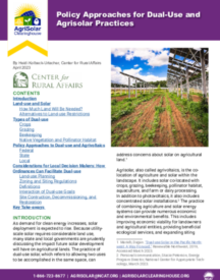As demand for clean energy increases, solar deployment is expected to rise. Because utility-scale solar requires considerable land use, many state and local governments are prudently discussing the impact future solar development will have on agricultural lands. The practice of dual-use solar, which refers to allowing two uses to be accomplished in the same space, can address concerns about solar on agricultural land.
Agrisolar, also called agrivoltaics, is the co-location of agriculture and solar within the landscape. It includes solar co-located with crops, grazing, beekeeping, pollinator habitat, aquaculture, and farm or dairy processing. In addition to photovoltaics, it also includes concentrated solar installations. The practice of combining agriculture and solar energy systems can provide numerous economic and environmental benefits. This includes improving economic viability for landowners and agricultural entities, providing beneficial ecological services, and expanding siting opportunities for solar deployment.
The purpose of this report is to provide decision makers and others an overview of policy approaches to combining solar with agriculture and offer considerations on how regulations can facilitate dual-use.


